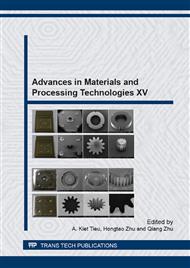p.400
p.409
p.414
p.420
p.429
p.437
p.448
p.454
p.461
Optimization of Cutting Parameters for End Milling AlSi/AlN Metal Matrix Composite Using the Taguchi Method
Abstract:
In this paper, the optimization of cutting parameters is investigated to assess surface roughness and cutting force in the end milling of AlSi/AlN metal matrix composite. Eighteen experiments (L18) with five factors (cutting speed, feed rate, depth of cut, volume of particle reinforcement, and type of coated insert) were performed based on Taguchi designs of the experiment method. Two types of coating (TiB2 and TiN/TiCN/TiN) of the carbide cutting tool were employed to machine various volumes of AlN particle (5%, 7% and 10%) reinforced AlSi alloy matrix composite under dry cutting conditions. Signal-to-noise (S/N) ratio and analysis of variance (ANOVA) were applied to investigate the optimum cutting parameters and their significance. The S/N analysis of the obtained results showed that the optimum cutting conditions for the cutting force were; A2 (triple coating of the insert), B2 (cutting speed: 200m/min), C1 (feed rate: 0.6mm/tooth), D1 (axial depth: 0.6mm) and E1 (5% reinforcement). At the mean time, the optimum cutting conditions for surface roughness were; A1 (single coating of insert), B3 (cutting speed: 250m/min), C2 (feed rate: 0.75mm/tooth), D1 (axial depth: 0.6mm) and E1 (5% reinforcement).The study confirmed that, with a minimum number of experiments, the Taguchi method is capable of determining the optimum cutting conditions for the cutting force and surface roughness for this new material under investigation.
Info:
Periodical:
Pages:
429-436
Citation:
Online since:
November 2013
Price:
Сopyright:
© 2014 Trans Tech Publications Ltd. All Rights Reserved
Share:
Citation:


